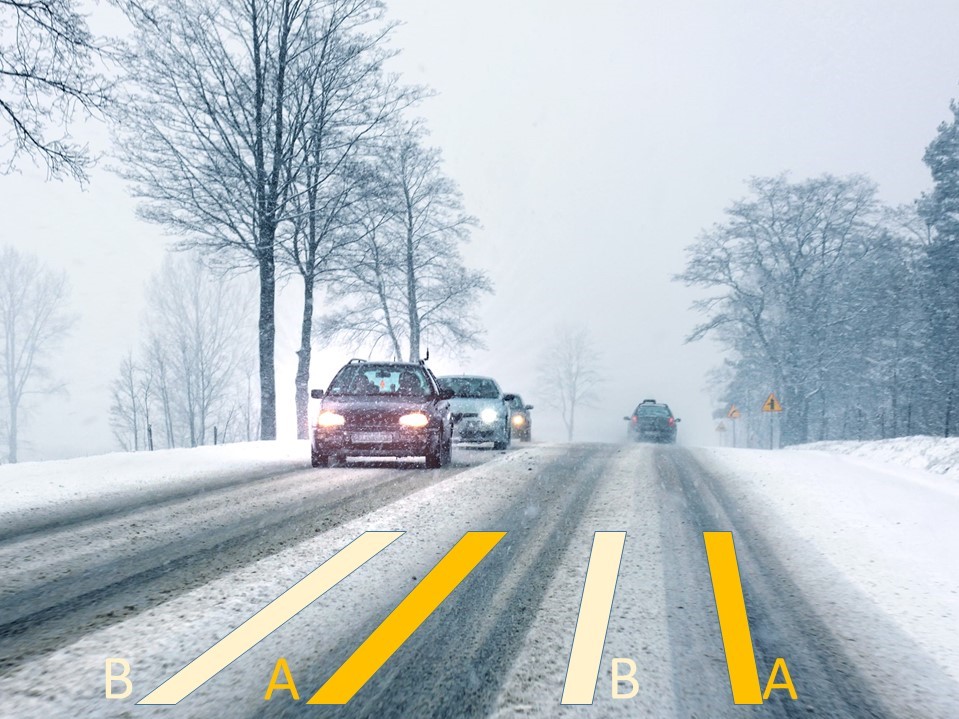Overview
Snow and ice causes many road accidents. The reason for this is snow and ice make the road more slippery and also more difficult to maneuver in. Its good to keep a greater distance between cars when in winter road conditions. Also listen to how the ice or sluch is spraying against the bottom of your car as this can sound different on different surfaces (See below)
 Hard packed snow at an intersection
Hard packed snow at an intersectionHidden danger in winter road conditions
- Lots of snow and ice on the road:Not dangerous as you anticipate there is snow and ice all around you thus you drive more safely
- Small amount of ice either on the side of the road or at an intersection: More dangerous as the road is generally safe until you drive over an icy spot that will make your car spin out of control
Freezing rain
Freezing rain occurs when warm oceanic air rises up and over cold air, it produces liquid precipitation that falls through a cold layer of air. When the falling rain droplets go through the cold layer, they become supercooled and freeze when contacting a surface. Freezing rain occurs when:
- Temperature 0°C
- Rain freeze when touching the road surface
- Reduces road friction really quickly, and can be very dangerouse
Snow tracks
As more cars drive over the snow on a road, it will for a clear snow track. The best traction is in the snow tracks. If you go outside the snow tracks you might risk sliding or steering difficulty
 Snow tracks (A) is most suitable.
Snow tracks (A) is most suitable.How to listen for icy roads
You will need to be able to distinguish between ice and snow. The following will give an idea of how to determine if its ice or snow
- Temperature < +4°C.
- There is no slush or splash sound (Result of frozen water)
- At intersections, snow is compressed (Hard pressed snow)that is then polished by vehicles driving over the snow several times. This makes the hard pressed snow very slippery and icy
- Cold and dark areas of the road (Road section under a tree, etc) don't unfreeze like all the other areas. This can then cause remaining snow in that areas to become icy
- Bridges and viaducts are cooled from above and below. There is a great risk of icy forming on them
Always take winter clothes and equipment with you during short rides
Even if you just quickly need to drive to the grocery store in -5°C, its always good to have winter equipment and clothes with you. Reason being if the car breaks down for any reason, you can get out and fix or inspect the issue with your winter clothes.
Other equipment to take
- Mobile telephone
- Snow shovel
- Towline
- Warm jacket / clothes / long pants
- High visibility vest
- Jumper cables
- Ice scraper
Slippery roads during the seasons
Spring
- Sun is still warming up parts of the road. There might be some patches of ice remaining where the road is cold
- Nights are generally still very cold and icy
Summer
- Very hot summer days, the sun bakes the surface of the road so warm that the asphalt get slippery
- After a long time of no rain, a lot of oil and dirt builds up on the road surface. When it rains again all this oil and dirt is washed and make the road surface very slippery
Autumn
- First ice that falls in Autum tends to catch many motorists by surprise. They are so used to driving on normal roads. When the icy starts falling, the drivers continue to drive as normal which can cause an accident
- Tree leaves that fall on the road surface are very slippery.
- Farm vehicles (Tractor, etc) drag dirt onto the road. This can make the surface more slippery
